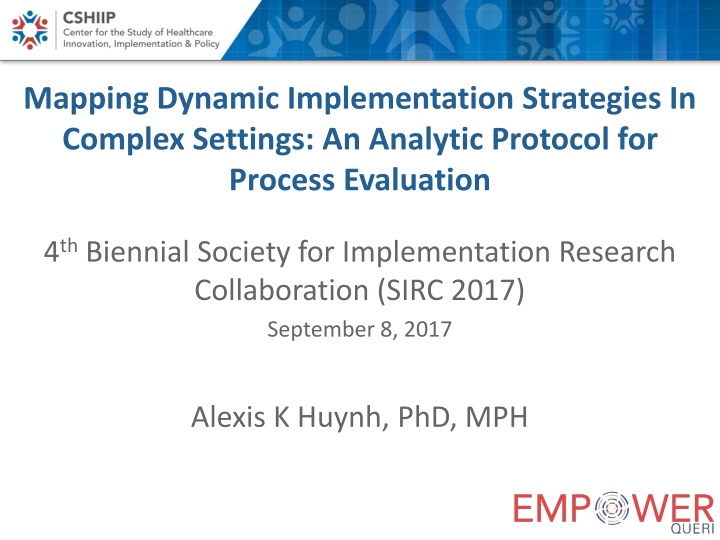
Innovative Strategies for Evaluating Healthcare Implementation Processes
Explore a study on dynamic implementation strategies in healthcare settings, focusing on assessment methods and challenges. Learn about the EMPOWER QUERI initiative and Replicating Effective Programs for improving women's health in the VA system.
Download Presentation

Please find below an Image/Link to download the presentation.
The content on the website is provided AS IS for your information and personal use only. It may not be sold, licensed, or shared on other websites without obtaining consent from the author. If you encounter any issues during the download, it is possible that the publisher has removed the file from their server.
You are allowed to download the files provided on this website for personal or commercial use, subject to the condition that they are used lawfully. All files are the property of their respective owners.
The content on the website is provided AS IS for your information and personal use only. It may not be sold, licensed, or shared on other websites without obtaining consent from the author.
E N D
Presentation Transcript
Mapping Dynamic Implementation Strategies In Complex Settings: An Analytic Protocol for Process Evaluation 4thBiennial Society for Implementation Research Collaboration (SIRC 2017) September 8, 2017 Alexis K Huynh, PhD, MPH
Acknowledgement Co-authors: Erin Finley, Melissa Farmer, Bevanne Bean-Mayberry, Alison Hamilton Funding provided by VA QUERI (QUE 15-272) Disclaimer: The views expressed in this presentation are those of the authors and do not reflect the position or policy of the Department of Veterans Affairs or the United States Government
Background Implementation Strategies Methods or techniques used to enhance adoption, implementation, and sustainability of a program or practice1 Constitute the how to component of changing health care practice1 Importance of Implementation Strategies Overcome barriers to realize the benefits of evidence-based care in routine practice Assessment of approaches to implementation that are more or less effective in different settings
Background Greater precision in reporting implementation strategies moves the science forward Persistent challenges in describing implementation strategies Varying terminology Multi-component strategies Variable utilization (dose, frequency) Measurement and replication Need innovative approaches to evaluate multiple strategies across project phases and settings
EMPOWER QUERI Strengthen VA women s health organizational capacity for innovation in patient-centered care Three implementation projects addressing women s health needs Replicating Effective Program (REP) guides evaluation in project phases
Cardiovascular (CV) Toolkit Multi-site implementation of a patient- and provider-facing toolkit: Increase CV risk identification & documentation Enhance patient-provider communication Engage women Veteran patients in appropriate services CV Toolkit components: CV Patient Screener CPRS Template Referral to services including the Gateway to Healthy Living Group & follow-up phone calls Provider and patient education, shared decision making
Objective Describe a protocol for mapping REP implementation strategies to outcomes facilitating Prospective simulation-based implementation plan refinement Longitudinal evaluation
Methods: Strategy Matrix Apply Proctor s recommendations to characterize and map strategies by specifying a matrix: Actions taken Discrete strategies Strategy conceptual categories REP phase(s)
Methods: Matrix Linking REP Phase Activities, Implementation Strategies &Components REP Pre-implementation a. Develop package b. Distribute & discuss package c. Identify champion ERIC Implementation Strategy Compilation e.g. Build a coalition Provide local technical assistance Conduct educational meetings Proctor s Rubric Actor Action Action Target Temporality Dose Outcome Justification
Methods: Strategy Matrix Application of Proctor's Rubric Recommendations In Constructing Implementation Strategy Matrix Number Strategy Strategy Conceptual Cluster Pre-Condition Pre-Implementation Implementation Maintenance & Evolution S1 Involve executive boards Develop stakeholder interrelationships Adapt pilot package for WV Review potential sites with partners Send trainers for Gateway training Re-tailor as needed with spread S2 Build a coalition Develop stakeholder interrelationships Engage selected site Identify local champions Review business case S9 Develop formal implementation blueprint Use evaluative and iterative strategies Local tailoring with training & technical assistance of toolkit package Provide and elicit feedback to make modifications to implementation process S15 Provide local technical assistance Provide interactive assistance Discuss educational needs of WH teams at sites Launch large meeting at site; Additional training for each provider on the CPRS template; Assess additional need for provider training and technical assistance
Methods: Matrix Linking REP Phase Activities, Implementation Strategies &Components Outcome = CV Toolkit Adoption Strategies Provide local technical assistance Launch CV toolkit at site; Train PCPs on CPRS template Temporality Pre-Implementation
Results-Mapping Strategies Strategy Initiated in REP Phase Used once Use recurringly 1. Conduct local needs assessment 2. Inform local opinion leaders 3. Develop educational materials 4. Promote adaptability 5. Build a coalition 6. Conduct educational meetings 7. Tailor strategies 8. Provide local technical assistance 9. Involve executive boards 10. Identify and prepare champions Pre-condition Pre-condition Pre-condition Pre-condition Pre-condition Pre-condition Pre-condition Pre-condition Pre-condition Pre-implementation 11. Assess for readiness and identify barriers and facilitators (local resources) 12. Develop formal implementation blueprint 13. Audit and provide feedback 14. Purposely reexamine the implementation 15. Conduct cyclical small tests of change 16. Develop an implementation glossary Pre-implementation Implementation Implementation Implementation Implementation Maintenance & Evolution
Results-Simulated Implementation Scenarios
Discussion Mapping & delineating implementation strategies, activities & outcomes Assess strategies deployed over time (once vs recurringly) Iterative and interactive process that refine implementation plans/activities Identify key strategies to improve outcomes
Practice Implications Operationalizing and specifying implementation strategy contexts Advance understanding of how simulation can be used to refine implementation blueprints during early stages Exciting developments include using participatory systems dynamics modeling to improve implementation planning
Questions & Comments Thank you for your attention
Selected References 1. Proctor, E.K., Powell, B.J. and McMillen, J.C., 2013. Implementation strategies: recommendations for specifying and reporting. Implementation Science, 8(1): 139. 2. Kilbourne, Amy M., et al. "Implementing evidence-based interventions in health care: application of the replicating effective programs framework." Implementation Science 2.1 (2007): 42. 3. Simpson, Kelly M., et al. "Tool for evaluating research implementation challenges: a sense-making protocol for addressing implementation challenges in complex research settings." Implementation Science 8.1 (2013): 2. 4. Powell, Byron J., et al. "A refined compilation of implementation strategies: results from the Expert Recommendations for Implementing Change (ERIC) project." Implementation Science 10.1 (2015): 21. 5. Sogolow ED, Poll LSKLS, Neumann MS. Strengthening HIV prevention: application of a research-to-practice framework. AIDS Education and Prevention. 2000;12:21-32. 6. Proctor EK, Silmere H, Raghavan R, et al. Outcomes for implementation research: conceptual distinctions, measurement challenges, and research agenda. Adm Policy Ment Health Ment Health Serv Res. 2011;38: 65-76. 7. Waltz TJ, Powell BJ, Matthieu MM, et al. Use of concept mapping to characterize relationships among implementation strategies and assess their feasibility and importance: results from the Expert Recommendations for Implementing Change (ERIC) study. Implementation Science. 2015;10(1):109. 8. Zimmerman, L., Lounsbury, D. W., Rosen, C. S., Kimerling, R., Trafton, J. A., & Lindley, S. E. (2016). Participatory system dynamics modeling: Increasing stakeholder engagement and precision to improve implementation planning in systems. Administration and Policy in Mental Health and Mental Health Services Research, 43(6), 834- 849.
Contact Information Alexis K Huynh, PhD, MPH Center for the Study of Healthcare Innovation, Implementation & Policy (CSHIIP) VA Greater Los Angeles Healthcare System Los Angeles, CA 90073 310-478-3711 x 49862 alexis.huynh@va.gov
Methods: Strategy Matrix Application of Proctor's Rubric To Implementation Strategy Matrix Number Strategy Strategy Conceptual Cluster Pre-Condition Pre- Implementation Implementation Maintenance & Evolution S1 Involve executive boards Develop stakeholder Adapt pilot package for WV Review potential sites with partners Send trainers for Gateway training Re-tailor as needed with spread interrelationships S2 Build a coalition Develop stakeholder interrelationships Engage selected site Identify local champions Review business case S9 Develop formal implementation blueprint Use evaluative and iterative strategies Local tailoring with training & technical assistance of toolkit package Provide and elicit feedback to make modifications to implementation process
Back-up Slide-Results Table 2b. Frequency of Strategy Implementation by Conceptual Cluster Number Involve executive boards Build a coalition Inform local opinion leaders Identify and prepare champions Develop an implementation glossary Conduct local needs assessment Conduct cyclical small tests of change Assess for readiness and identify barriers and facilitators (local resources) Develop formal implementation blueprint Audit and provide feedback Purposely reexamine the implementation Conduct educational meetings Develop educational materials Tailor strategies Promote adaptability S16 Provide local technical assistance Strategy Strategy Conceptual Cluster Develop stakeholder interrelationships Develop stakeholder interrelationships Develop stakeholder interrelationships Develop stakeholder interrelationships Develop stakeholder interrelationship Use evaluative and iterative strategies Use evaluative and iterative strategies Use evaluative and iterative strategies Use evaluative and iterative strategies Use evaluative and iterative strategies Use evaluative and iterative strategies Train and educate stakeholders Train and educate stakeholders Adapt and tailor to context Adapt and tailor to context Provide interactive assistance S1 S2 S3 S4 S5 S6 S7 S8 S9 S10 S11 S12 S13 S14 S15


![READ⚡[PDF]✔ Yup I'm Dead...Now What? The Deluxe Edition: A Guide to My Life Info](/thumb/20463/read-pdf-yup-i-m-dead-now-what-the-deluxe-edition-a-guide-to-my-life-info.jpg)


















